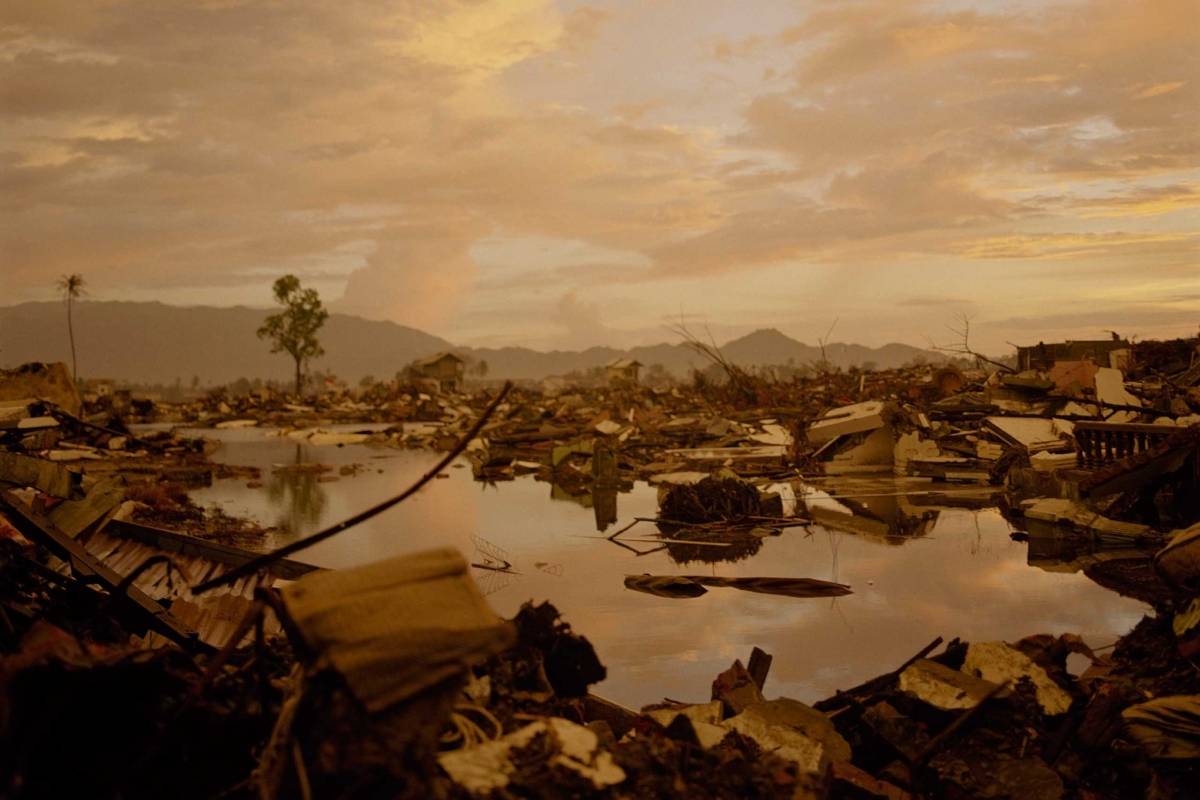It was just after 10:30 a.m. when Noppasri Jailak received a panicked phone call from a neighbor about water surging through their street. The 38-year-old immediately gunned his motorcycle taxi back to survey his neighborhood in the popular Thai coastal resort of Khao Lak. The utter devastation shocked him. “I didn’t know what a tsunami was,” he says, “nobody did.” Although his sodden house was still standing, his three daughters — aged 10, 12 and 13 — were nowhere to be seen. Gripped by panic, he scoured the serrated emerald landscape. “I couldn’t find them for two days and two nights,” he says.
Noppasri eventually located his children unharmed up in the lush hillside where they had fled. But his wife, Yet, was not so lucky. The 36-year-old was working in the kitchen at the nearby Baan Andaman Hotel when the wave struck. By the time Noppasri and his brother-in-law found her body, lumped among hundreds of others at a local temple, it was so bloated she could only be recognized by a gold ring. “I wept and wept,” Noppasri tells TIME, head bowed beneath a pewter sky. Dec. 26, 2004, was his 15th wedding anniversary.
More than 230,000 people died across the Asia-Pacific in the tsunami, meaning such tales of loss are only too common. Deaths were recorded in 14 countries and as far afield as South Africa, although the four worst affected nations were Indonesia, Sri Lanka, India and Thailand in declining order. The 9.3-magnitude earthquake that struck 160 km (100 miles) off northwest Sumatra was the third largest ever recorded, lasting an unprecedented nine minutes and causing the whole planet to vibrate 1 cm (o.4 in.). And to some extent, 10 years on, those vibrations are still being felt.
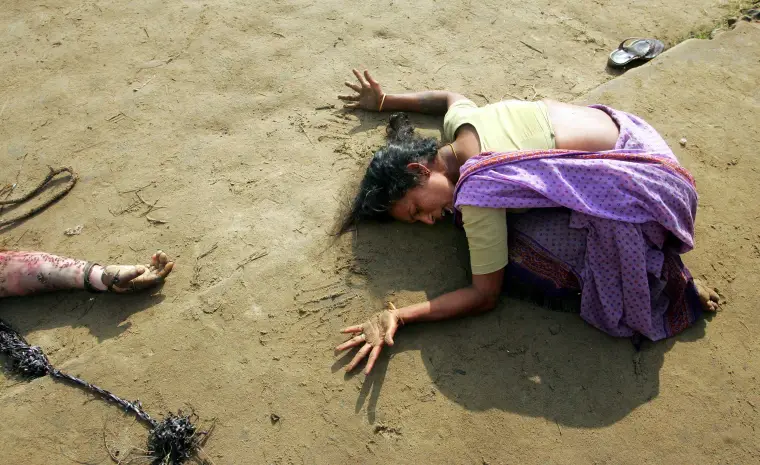
Nurlaili and her mother had just finished breakfast in Lampuuk, a village in the Indonesian province of Aceh, the war-torn westernmost tip of Sumatra, when the earth started trembling. As the shaking grew to powerful convulsions, they rushed outside for fear that their house would collapse. After a couple of minutes calm returned, but then two explosions ripped through their community. Nurlaili, then 23, heard her brother scream, grabbed his hand and started running.
Nurlaili didn’t see the water until it swept her off her feet, tumbling her around and knocking her unconscious. She awoke to find herself stuck in barbed wire. Then the next wave struck, ripping her loose, and dragging her down. “I didn’t know how to swim, but tried to copy what I’d seen in Jaws,” she says. “My aim was to reach the rooftops.”
The third and last wave left Nurlaili partially submerged in a neighboring village. A man heard her cries and carried her to dry land next to a cemetery. There she lay for hours, bleeding from a wound that had nearly severed her right foot. By the time she was airlifted to have her leg amputated, several days later, she was so weak that the slightest movement made her faint. Every time she passed out, her mother appeared in a ghoulish vision, imploring, “Why aren’t you looking for me? Why aren’t you taking care of me?”
I have accepted my fate, but I feel trapped. I choose to think neither of the past nor the future. It just makes my head spin, I get depressed. Sometimes friends from primary school visit me in my dreams. I don’t know why. I see them up on a hill, while I’m standing on the ground.
— Nurlaili
In Thailand, half of the 5,000 confirmed dead were tourists. John Thompson, then 28, was woken up by his room shaking at around 8 a.m. “I thought it was construction next door,” he says. After breakfast, the native of Santa Rosa, Calif., took his rental motorbike out for a spin to clear away the postfestivities fug, stopping briefly by a beach in Khao Lak to snap some photos. There, he was puzzled to see a long-tail boat struggling in the breaks. After seven seconds the previously empty bay was filled with water. “I was probably one of the first to start running,” he says.
A split-second decision to dart up some concert steps into a hotel very likely saved Thompson’s life. “I remember thinking should I yell out to other people and encourage them to come into the hotel too,” he says, “I kind of regret that I didn’t, but at the same time you never know which buildings were going to fall down.” For two hours he stayed on a balcony helplessly watching the murky water swirl around, the previously pristine beach decimated by a merciless force of nature.
The energy released as the Indian plate was subducted by the Burma plate was equivalent to 1,500 Hiroshima bombs, and displaced 30 cu km (7.2 cu. mi.) of water. The tsunami wasn’t triggered from a particular point, rather a line of source running roughly north to south that stretched some 1,600 km (1,000 miles). The resulting waves dispersed in an east-west direction, felt as far away as Chile, but having minimal effect north or south. In contrast, low-lying Bangladesh suffered just two confirmed fatalities despite being barely 800 km (500 miles) north of the fault line.
Around 65 km (40 miles) down the coast from Thompson, Trevor Fisher was en route to Catholic mass on Thailand’s bustling resort island of Phuket. As he neared the beachside Laguna Resort, halfway down the island’s west coast, a torrent of beach furniture suddenly washed over sandbanks and into the hotel’s ornamental lakes. Terrified staff raced past, traditional long skirts hitched above their knees, beseeching him to flee. “I’ll always remember that amid all this mayhem one guy still insisted on calling me ‘Sir,’” he recalls.
After leading his partner and son to higher ground, the 30-year-old Brit made a beeline for Phuket International Hospital. Fisher felt sure his decade of experience as a nurse specializing in sudden traumatic death, as well as his command of several languages, would prove invaluable.
The first few patients had suffered only minor injuries. After 10 minutes, though, the ward was filled with compound fractures and massive lacerations caused by floating debris. Drowning isn’t the only way to die in a tsunami. “The water itself is dangerous,” said Fisher, “but it turns into a washing machine full of metal and glass when it picks stuff up.”
In the hospital, Fisher helped lucky survivors reunite with loved ones they presumed lost, using a network of phone contacts and a hastily setup computer database. That unique brand of relief produces “a howl, a wail from deep within,” he says. It is not a sound of joy, says Fisher, but “a guttural, animal outburst that almost compels you to join in, and it brought tears to my eyes.”
But along with reunions, there were the countless bereaved in desperate need of consoling. “Grief is a profound thing that stays with people forever, and every word that’s spoken to you — especially by a professional — weighs much more than any other words you’ll hear your entire life,” says Fisher.
A large number of Scandinavians had been soaking the Thai winter sun, and with 543 confirmed fatalities, Sweden was the nation worst affected by the tsunami outside of Asia. No larger number of Swedes had been killed in a single incident since 1709, when the troops of Russia’s Tsar Peter the Great ran amok at the Battle of Poltava in present-day Ukraine.
An older Scandinavian couple walked with their arms outstretched as if sleepwalking, across the room towards each other. Red-faced with tears streaming down their cheeks, they passed everyone as though they weren’t there, uninhibitedly shouting each other’s names until they could finally touch each other. The man held his wife’s face in his hands and his whole body quaked. She kissed his forehead and said his name, again and again and again, “Gunnar, Gunnar, my Gunnar,” and he said hers, “Elsa, Elsa, Elsaaaa.”
— Trevor Fisher
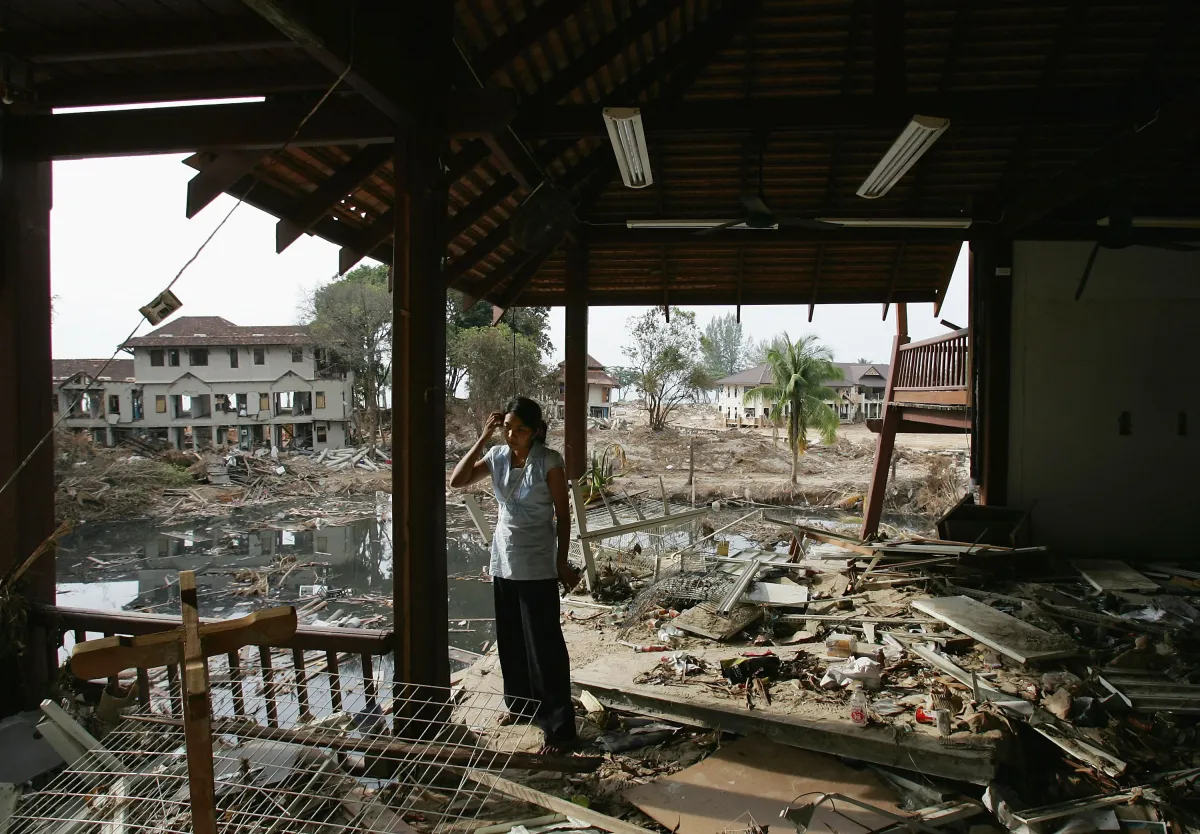
In Sri Lanka, where some 35,000 people died, Dec. 26 was both a Christian celebration and a Buddhist public holiday, and throngs were returning to their home villages. The morning Galle Express train was just passing the southern tourist town of Hijkeuwa when a wall of water picked up its eight packed carriages and hurled them in all directions. Tons of steel rail track were twisted upright to resemble a giant picket fence.
Venerable Baddegama Samitha, a Buddhist monk who was also formerly a local MP, arrived in the aftermath to help perform funeral rites for around 1,000 people entombed inside the train. The students who accompanied him “couldn’t sleep for three weeks after recovering the bodies,” he says. Lost sandals and scraps of clothing littered the site. Recovered Muslims were handed back to their communities to be buried according to their rituals, says Samitha. In total, some 15% to 20% of the population living within 1 km of the coast in eastern and southern provinces was wiped out. “In different ways, every bit of life was affected,” he adds.
More than 12,400 people died in India, two-thirds of them in the southern state of Tamil Nadu. In these impoverished coastal communities, life revolves around religion and fishing. Fishers have incredible — to outsiders, almost telepathic — knowledge and understanding of the sea, tides, weather patterns, fish habits, seabed, phases of the moon, and so on. “If I cannot fish, I am nobody,” one local told researcher Sally Beckenham, who is studying the Indian tsunami response for her doctorate at King’s College London.
But along with countless lives, the tsunami washed this sense of purpose away. That this was a “disaster wrought by Mother Sea,” and was unforeseen, accentuated an acute sense of loss and betrayal — the font of life for boundless generations transformed into a maniacal destroyer. Survivors experienced insomnia and hypervigilance. Alcoholism skyrocketed. Children avoided school terrified of abandonment.
For Indian women, the associated stigma of nakedness was shattering. In a focus group conducted by Beckenham, 10 out of the 14 participants had either regained consciousness to find they were nude or had to remove their clothes after becoming tangled up in debris and almost throttled. “They have nightmares and feel shame and embarrassment still, 10 years on, that their bodies were seen,” says Beckenham. In a shocking number of cases, women were found dead in trees or bushes wrapped in their saris, as they refused to disrobe and save themselves. The humiliation was just too strong.
In southern Thailand, most bodies were taken to Khao Lak’s Wat Yan Yao temple for storage and identification. Dr. Pornthip Rojanasunand had only set up Thailand’s Central Institute of Forensic Science two years previously. “It was the first time in my life I was faced 1,000 bodies,” she tells TIME. Pornthip’s team had no protocols for a tragedy of this scale, and so quickly devised their own — for the first two days photographing all bodies, as they were still in good condition, and photos offered the simplest route toward identification. After that it was “dental records, finger prints and lastly DNA,” she explains.
Mountains of dry ice were needed to keep the corpses cool, but even then they quickly began to decompose in the blazing tropical heat. Armies of volunteers struggled to stay conscious, hauling putrid remains into groups based on size, gender and hair color. “Women with black hair, women with blonde, men with black, children with blonde,” explains Pornthip. People were terrified of disease, and despite rigorous cleaning procedures, helpers complained the stench of death hung on them for days.
Sri Lanka was in the midst of a brutal civil war, waged between the central Colombo-based government, dominated by the Singhalese-Buddhist majority, and the rebel Liberation Tigers of Tamil Eelam (LTTE), otherwise known as the Tamil Tigers. These ferocious, mainly Hindu guerrilla fighters occupied large swaths of this teardrop island’s north and east. (The nation also boasts smaller Christian and Muslim populations.)
Chandru Pararajasingham was director of the Tamil Rehabilitation Organisation and helped tsunami-relief efforts by setting up hundreds of displacement camps in the northeastern Mullaitivu region. The area was already reeling from a heavy monsoon, which had claimed dozens of lives in mudslides, also hampering later relief efforts. “It was like a war zone,” says Pararajasingham. “I was shocked to see that buildings — strong, big buildings — had just collapsed.”
At first there was significant coordination with central government about how to get supplies to rebel-controlled areas. However, “the animosity between the government and LTTE resurfaced after a couple of weeks,” says Pararajasingham. Despite the signing of a Norwegian-brokered Post-Tsunami Operational Management Structure (PTOMS) agreement, it was never implemented because of infighting within the coalition headed by Prime Minister Chandrika Kumaratunga.
The first few days after the wave were occupied with disposing of dead bodies and erecting temporary shelters, first in churches, temples and schools slightly inland — the few structures robust enough to have survived. Simple homes of corrugated iron and wood were later built. It took only a year to return to the “basic, basic status quo” in rebel areas, says Pararajasingham. This was largely due to thousands of Tamil diaspora who returned to help out. “To be fair to all parties, I think a hell of a lot was achieved in 12 months,” he says.
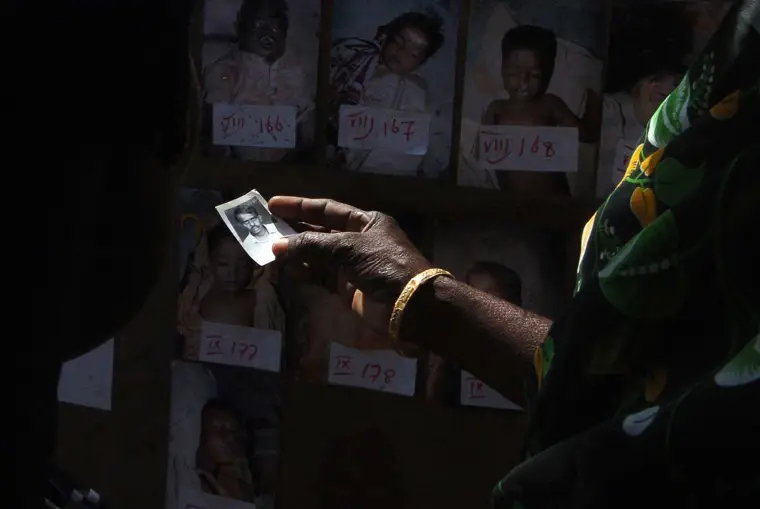
The fishing industry was decimated across much of the Asia-Pacific. While charitable drives replaced the shattered vessels, fishermen then faced a psychological battle. “The story went around that so many bodies were eaten by the fish, and so eating fish was like eating your own people’s flesh,” says the monk Samitha. “To replace that mentality took a long time.”
Destruction was not confined to the coast. In ocean several kilometers deep, tsunamis travel incredibly quickly — up to 970 km/h (600 m.p.h.) — yet form a barely noticeable hump. But as the water shallows near the coast, the waves slow to perhaps 80 km/h (50 m.p.h.) but form powerful towers up to 30 m (100 ft.) high that can swamp land several kilometers inland from the coast.
In Aceh province, the 2,600-ton Apung 1 electric-generator ship was flung over 2 km (1.2 miles) onto a nearby hillside, where it still remains, a popular tourist attraction. Visitors use purpose-built gangways to reach its roof, and mounted binoculars to gaze across the sprawl of rooftops. Shopkeepers sell souvenirs and hawkers peddle documentary DVDs.
But the layer of seawater several stories high wrought a biblical havoc on agriculture, effectively sowing fields with a layer of salt, leaving them sterile. Thousands of Sri Lankan rice paddies as well as mango and banana plantations were destroyed, and drinking water wells contaminated. The situation was repeated on arable land everywhere the tsunami struck.
The epicenter of the quake traced India’s Andaman Islands, and there were significant fears over the aboriginal Onge tribe. However, there is no record of a single casualty in the tsunami, as all sought higher ground or took to the seas as their ancestors had done for 50,000 years before, riding over the hump before it developed its destructive force.
The disaster saw a tremendous fundraising campaign from around the globe. Some $14 billion in aid was raised for affected regions; the U.S. eventually contributed $350 million after a roundly criticized initial pledge of $35 million.
A huge amount of cash was focused on preventing the potential spread of diseases such as cholera, diphtheria, dysentery and typhoid, which can thrive in contaminated water and in refugee camps. Thanks to the swift action of health workers, such outbreaks — which could have multiplied the already unbearably high death toll — were negligible. Even in impoverished northeastern Sri Lanka, “I don’t recall that we even had a single case of diarrhea,” says Pararajasingham.
Indonesia’s province of Aceh was worst hit of anywhere across the world. In Lampuuk, over 90% of inhabitants perished. Across the province, says UNICEF, some 2,800 children were orphaned. That number may seem low considering Aceh itself experienced at the very least 130,000 fatalities, more than half the global total. But the reason is simple, and grim — half the total dead were themselves children.
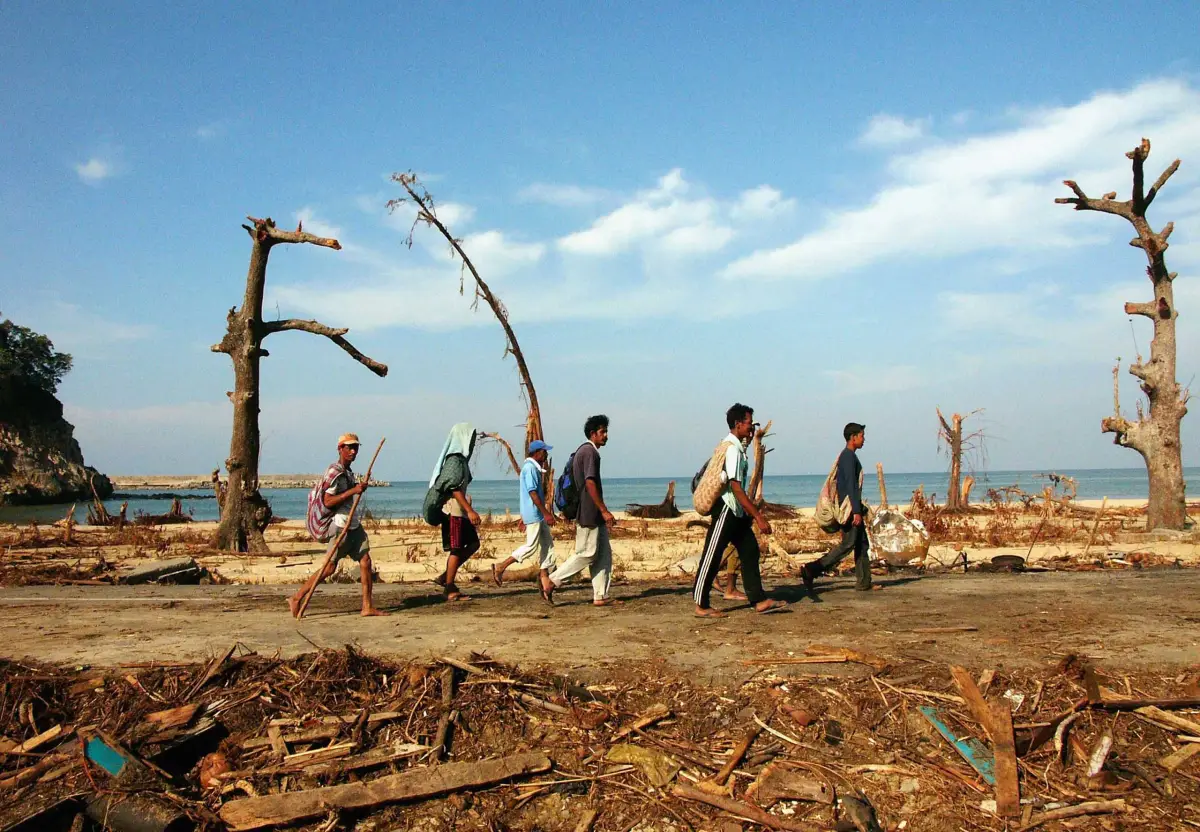
The desolation prompted the rebel group Gerakan Aceh Merdeka, or Free Aceh Movement, to call a cease-fire after just two days, and peace talks were soon resumed with the Indonesian government. Since 1976, these hardened guerrillas had battled central government in Jakarta, at a cost of some 15,000 lives. On Aug. 15, 2005, a deal, facilitated by former Finnish President Martti Ahtisaari, was signed, and it remains in place today. The treaty explicitly cites the tsunami as a catalyst. Aceh was granted relative autonomy, and the people of the island were ready to stake out their distinct path forward, once they’d risen from the rubble.
In Sri Lanka, there were also initial signs of that the tsunami may end a civil war that had raged since 1983 and killed more than 100,000. “I think the international community wanted to use this as a catalyst to make peace,” says Pararajasingham. But in November 2005, the hawkish President Mahinda Rajapaksa, who remains in power today, was first elected upon promises to take a harder line with the then powerful LTTE. Suddenly, says Pararajasingham, everything “was on a war footing and things deteriorated from that point onwards.” In May 17, 2009, the Tamil Tigers were finally routed following a blitzkrieg that claimed at least 70,000 civilian lives, according to the U.N., which alleges serious war crimes. Today, Sri Lanka is at peace but its Tamil minority complains of ongoing marginalization and persecution.
Across the Asia-Pacific region, many people permanently lost their homes in the tsunami. Ancestral lands were devastated, and in the aftermath it was difficult to establish definitively who lived where — especially when the land itself had been utterly remade by the waves. “The land we had is all gone in the ocean,” says John Robert, president of National Youth Congress for the Andaman and Nicobar Islands, of his family home in the Nicobar Island village of Gandhinagar. Before they had their own house with vegetable garden and livestock; now they live in a displacement colony of 1,200 people. Roads to the new government-funded housing have still not been built one decade on, because of red tape. “That life has not come back and will probably never will,” he adds.
What happened was a natural disaster, the tsunami was an act of nature, and there’s nothing we can do about that. But what was supposed to happen after that went completely wrong and was very unjust.
— John Robert
In Thailand, developers took the opportunity to move their tourist resorts nearer the coast, where beach access is better and thus room rates higher. The hotel where Thompson stayed in Khao Lak disappeared, and “they built this fancy, modern resort right next to the water — much closer than it used to be,” he says. “It’s really sad.”
This transformation was arguably most pronounced on Thailand’s stunning karst-cliff island of Koh Phi Phi, which served as the setting for the 2000 film adaptation of Alex Garland’s dystopian classic The Beach. Seventy percent of the island’s buildings were destroyed by the wave. Two thousand people died. Rebuilding work quickly became conflated with mass development, and large swaths of previously pristine beachfront were annexed for plush new resorts. It was disaster capitalism masquerading as altruism.
In India, landgrabs were rife. After the tsunami, the state government imposed restrictions on buildings within 200 m of the shore, but many former residents lacked title deeds to their land, and never received adequate compensation. New industrial projects, such as power plants and port complexes, exacerbated the problem. Fishing communities refused to move inland away from the beaches, choosing instead to live precariously, taking the risk of eviction by the police or hired goonda thugs.
But Aceh’s provincial capital of Banda Aceh is proof that it’s possible not only rebuild, but build back better. Traffic flows steadily on this Indonesian city’s wide and clean streets, a large park gives respite from the hustle and bustle, and crime is minimal. Outside Banda Aceh’s limits, solid villages of concrete houses have replaced their wooden predecessors.
Only a small fraction of those caught by the tsunami even knew what one was. That is certainly not true today. In southern Thailand, tsunami-warning signs punctuate the palm-lined shore, showing the quickest route to higher ground. When a quake takes place, sirens and text messages blanket the community. Regular lessons on how to react to a possible tsunami are held in schools and community centers.
The Indian Ocean Tsunami Warning System went live in June 2006. Data from seismographic stations and deep-ocean sensors are analyzed in Hawaii and Japan where appropriate warnings can be dispatched to national offices to be disseminated via radio, television, Internet, SMS and even loudspeakers on the beach.
In April 2012, millions ringing the Indian Ocean where shepherded away from the coast when an 8.6-magnitude earthquake off northern Indonesia sparked fears of a tsunami. Yet some still doubt the system’s effectiveness, and Indonesia admitted soon after that quake that just three of the 25 buoys in its national waters were operational, thanks to vandalism. In Aceh province, there were also reports that some sirens failed during the emergency. There are also fears that despite the rebuilding, many houses are not strong enough to withstand the next quake or tsunami.
Sri Lanka has established an early warning system — through speakers, sirens and even messengers on motorbike — but relies on the wider regional network for that initial signal. Awareness has been elevated, though, and local people have generally mapped out preferred escape routes in case of such an emergency.
The Indian government currently relays tsunami warnings to officials in the Tamil Nadu state government. Yet with many small villages very much off the grid, and Internet and telephone connectivity spotty at best, there is no guarantee alerts arrive in time. As with in 2004, the poorest still remain at most risk.
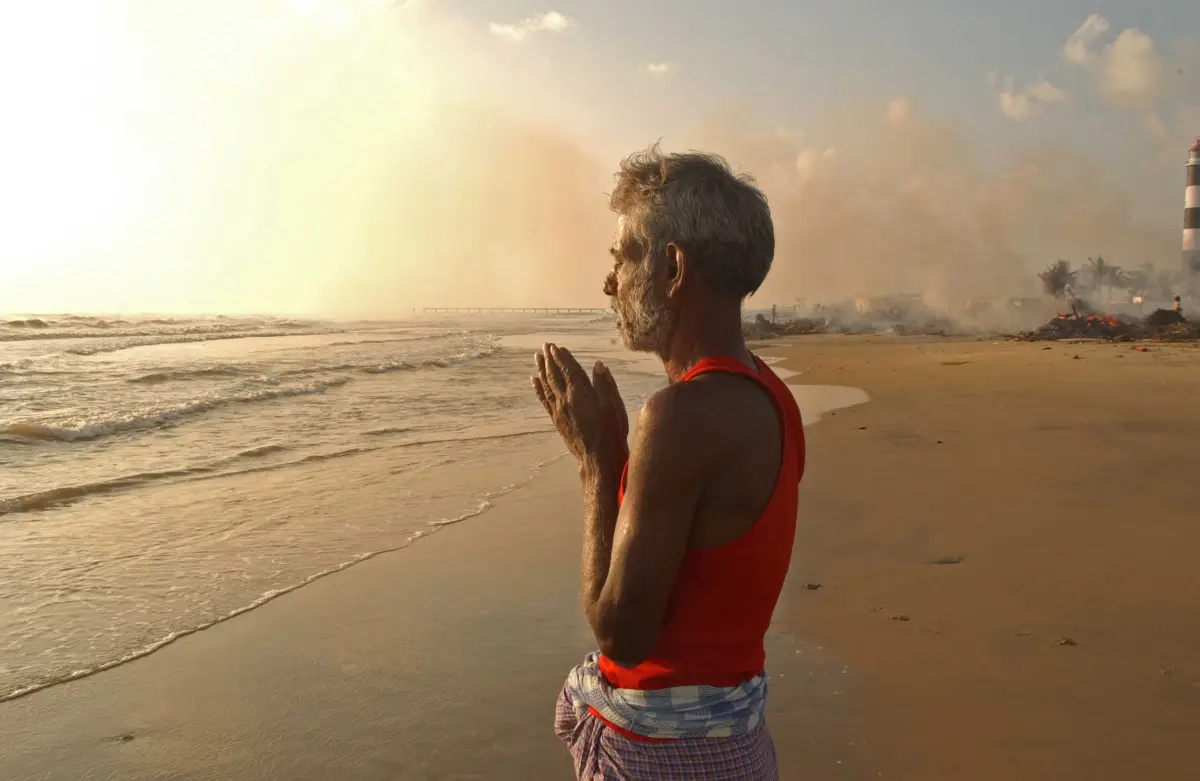
For Pornthip, the Thai scientist, a corollary of the tsunami was that people suddenly appreciated the necessity of her work. Whereas a policeman’s testimony would previously trump forensic evidence in court, her success reuniting families with deceased relatives made the Thai public see DNA as more dependable. This has helped thwart official corruption, she says: “People understand why I have to fight with the police.”
After four years in a temporary shelter, Nurlaili and her brother moved into one of the sturdy houses raised by the Turkish Red Crescent on the site where their old village used to stand. Their mother’s body was never found, and since their father was long gone before the tsunami, they’ve had to care for themselves.
Or rather, Nurlaili’s brother had to care for her, as she hasn’t been able to find employment, and her prosthetic legs have broken down one after another. “The first years, I just wanted to die,” says Nurlaili. “Losing a leg, I felt abnormal.” Now she stays at home all day, cleans the house and tends to the flowers while her brother works.
Back in Khao Lak, Noppasri struggled to put Yet’s death behind him. Noppasri lost 20 close family members in the tsunami, robbing him — like most of the community — of badly needed familial support. “I found it very difficult to pay for everything, to find time to care for them and work, and also to understand them — as they are three girls,” he says.
Although now remarried and driving a four-wheeled taxi, he has had no more children, but is eagerly awaiting the birth of his first grandchild. On Dec. 26, like so many other bereaved in Khao Lak, he will visit the local temple. There, he will light a candle to reflect on the lives lost, and the new life approaching. And the sea, always in the background, will brood in its place.
— With reporting by Per Liljas / Banda Aceh and Rishi Iyengar / Hong Kong
— With video by Per Liljas / Banda Aceh and Khao Lak, and Helen Regan / Hong Kong
